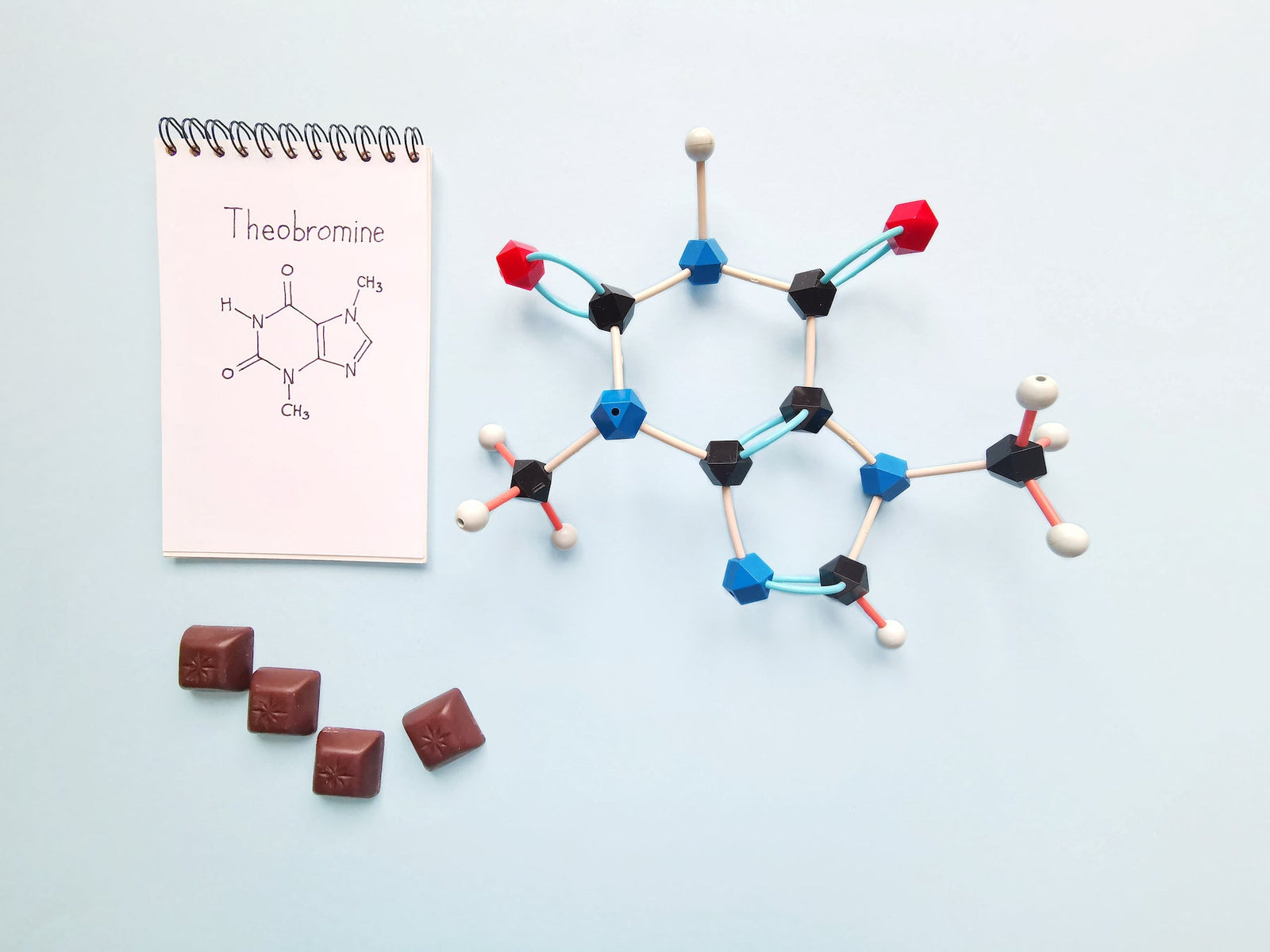The Complete Guide to Theobromine: How It Works, Benefits, and Potential Effects
Introduction
Theobromine, also known as xantheose, is the primary alkaloid found in the cacao bean—the very compound responsible for many of dark chocolate’s health benefits. While most people associate chocolate with its caffeine content, it’s actually theobromine that does the heavy lifting when it comes to cardiovascular support, neuroprotection, and mood elevation.
In this article, we’ll explore how theobromine works, its therapeutic benefits, how it compares to caffeine, who it’s best for, and how to stack it effectively.
What Is Theobromine?
Theobromine is a naturally occurring alkaloid found predominantly in cacao beans, and to a lesser extent in tea leaves and guarana. It’s structurally similar to caffeine, but with a milder stimulatory profile.
Alkaloids serve an evolutionary purpose in plants by protecting against predators and regulating growth. Therapeutically, they are widely used in medicine due to their effects on the cardiovascular system, central nervous system, and inflammation pathways.
“Theobromine is the major methylxanthine found in chocolate and has physiological effects similar to, but milder than, caffeine.” — Mitchell et al., Journal of Nutrition
Theobromine is commonly found in pre-workout supplements, fat burners, and nootropics, thanks to its stimulatory, vasodilatory, and focus-enhancing effects.
How Does Theobromine Work?
Theobromine, like caffeine, belongs to a group of alkaloids called methylxanthines. These compounds antagonize adenosine receptors, blocking the neurotransmitter that promotes drowsiness—thereby increasing mental alertness and wakefulness.
Your body actually metabolizes caffeine into three molecules:
-
Paraxanthine (84%)
-
Theobromine (12%)
-
Theophylline (4%)
Unlike caffeine, which peaks in 30–45 minutes, theobromine’s half-life is 6–8 hours, peaking in about 2–3 hours—providing a smoother, longer-lasting stimulant effect.
“Theobromine exhibits a slower onset and longer half-life than caffeine, which may explain its reduced but sustained stimulatory effects.” — Benowitz, Clinical Pharmacology & Therapeutics
Theobromine vs. Caffeine: A Quick Comparison
| Feature | Theobromine | Caffeine |
|---|---|---|
| Stimulant Intensity | Mild | Strong |
| Half-Life | 6–8 hours | 3–5 hours |
| Peak Onset | 2–3 hours | 30–45 minutes |
| Effects on Mood/Focus | Smooth focus, calming | Fast alertness, jitter-prone |
| Common Sources | Cacao, dark chocolate | Coffee, energy drinks |
| Jitteriness Risk | Low | Moderate to high |
Theobromine Benefits
Cardiovascular Health & Vasodilation
Theobromine has demonstrated vasodilatory effects, which can widen blood vessels, reduce arterial stiffness, and enhance circulation without significantly impacting blood pressure.
“Consumption of flavanol-rich cocoa significantly improved endothelial function, increasing flow-mediated dilation by 30%.” — Balzer et al., Journal of Cardiovascular Pharmacology
In a 4-week randomized crossover trial, 30 overweight men consumed 814 mg/day of cocoa flavanols, resulting in a 22% increase in basal blood flow and 6% dilation of the brachial artery.
“Daily cocoa consumption improved vascular tone and blood flow in overweight individuals.” — Heiss et al., British Journal of Nutrition
Neuroprotective Effects & Cognitive Enhancement
Theobromine offers neuroprotective benefits and has been shown to improve working memory and protect against ischemic damage in the brain.
“Theobromine pre-treatment significantly protected against neuronal damage and enhanced glutathione levels in brain tissue.” — Siddiqui et al., Neurochemistry International
It also activates the CaMKII/CREB/BDNF pathway, crucial for memory consolidation and cognitive function.
“Theobromine upregulated BDNF and CaMKII, which are closely linked to cognitive enhancement and synaptic plasticity.” — Kim et al., Journal of Functional Foods
Focus, Energy & Mental Clarity
Theobromine increases mental alertness without the harsh crash associated with caffeine. Its longer half-life provides sustained focus and performance.
“Theobromine’s action as an adenosine receptor antagonist promotes wakefulness and attentiveness without the jitters often associated with caffeine.” — Smit et al., Psychopharmacology
How to Stack Theobromine
Theobromine can be combined strategically with other supplements for enhanced performance or mood benefits:
-
L-Theanine – To balance stimulation with calmness
-
Caffeine – For synergistic focus and fat oxidation
-
Alpha-GPC or Tyrosine – For cognitive stacking
-
Green Tea Extract – For metabolic and antioxidant synergy (found in Greens+Reds)
Theobromine Dosage
Typical effective dosages include:
-
100–300 mg/day for focus, mood, and cardiovascular health
-
Up to 500 mg/day in fat-burners or pre-workouts
-
40g dark chocolate (70–85%) yields ~200–300 mg theobromine
“Dark chocolate offers both theobromine and flavonoids, contributing to vascular and cognitive benefits.” — Latif, Journal of Clinical Nutrition & Metabolism
Theobromine Side Effects
Theobromine is generally safe at moderate doses. However, high doses (above 500–600 mg) may lead to:
-
Headaches
-
Irritability
-
Nausea
-
Restlessness
“Side effects were generally mild and occurred only at high intakes (560–1000 mg).” — Zhang et al., Toxicology Reports
Safety Considerations & Special Populations
-
Pregnant and breastfeeding women should consult their physician due to limited data.
-
People with heart arrhythmias or stimulant sensitivity may want to avoid high doses.
-
Pet owners beware: Theobromine is toxic to dogs, even in small amounts.
“Theobromine is safe for humans but can be fatal to dogs due to their slow metabolism of methylxanthines.” — Pet Poison Helpline
Conclusion: Should You Supplement with Theobromine?
Theobromine may be lesser known than caffeine, but it offers tremendous value—from heart health and blood flow to mental clarity and mood enhancement.
-
Longer-lasting focus, no crash
-
Supports circulation, nitric oxide production
-
Enhances memory, neuroprotection
-
Fewer jitters, ideal for those caffeine-sensitive
If you're looking for a smooth, reliable performance booster—whether through dark chocolate or science-backed supplements—theobromine is a highly effective option.
Explore Swolverine's collection of clean, clinically dosed performance supplements to find theobromine blended into our fat burners, pre-workouts, and cognitive support formulas.
Find similar articles:
Supplements






